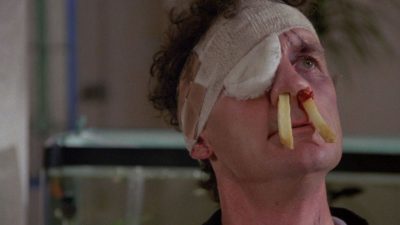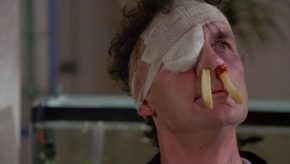Anikó Petri is currently in her third year of her Art History studies at the Courtauld Institute of Art. This is her first publication on Art Here Art Now.
Air pollution – the silent killer that is too abstract to truly grasp just how pervasive it is in our lives. Do we really know what effect pollutants have on our health? It is one thing reading statistics linking nine thousand premature deaths in London alone to polluted air, and yet another to understand how each of us is directly affected. As the coronavirus pandemic leads to a huge drop in air pollution, we investigate artworks that highlight the problem.
The 2010s as a decade could be characterised as the epoch when climate change, as a concept, entered the global mainstream consciousness. Despite the best efforts to reduce our collective carbon footprint, 2019 was also the second hottest year on record since 1850. Social media allows footage of natural disasters, such as the wildfires that ravaged Australia, to be normalised as part of the twenty-first century experience. The need for a wide-reaching global cooperation is becoming more prescient every day. That is, if we truly want to prevent a complete climate catastrophe and all that it entails.
These are terrifying prospects, and yet we go about their daily business in the city. Inhaling and exhaling absent-mindedly. Of course, I cannot fault anyone for their lack of vigilance when it comes to air pollution. Living in central London – one of the worst offenders in the world when it comes to the quality of the air – I find myself inexplicably out of breath, with irritated eyes and a sore throat that goes away as soon as I leave for the countryside. I wait for my train at least twice-a-day which emerges from the underground tunnel through a cloud of smog. I can smell the dust burning as it comes in contact with the electrical current passing through the tracks, but I try not to pay attention to it. In fact, I actively push it out of my mind. I fear the repercussions the city will have on my health, symptoms that may become apparent in twenty- or thirty-years-time. But I also don’t want to be consumed by climate anxiety.
We have become so saturated with statistics that it is often easy to bypass the numbers or feel as if there isn’t a lot we can do. Air pollution, however, must be addressed continuously as a cultural and social issue seeing as it is one of the most pervasive problems faced by city-dwellers day and night. One way to put an end to the complacency is through the centralisation of artists’ and designers’ voices. Primarily because the mediation of science through the visual is more digestible for the human psyche than numerical statistics. The following creatives are materialising the invisible presence of short-term pollutants, but they are also pioneering design tools that will enable us to be more responsible when it comes to living in areas with toxic air.
Air pollution: the issue that binds us all

Michael Pinsky is a British artist, whose Pollution Pods installation allows the audience to explore the air quality of different environments and different cities. The immersive installation is made up of five geodesic domes, all of which are climatically controlled by computers which monitor and recreate conditions of air quality, ozone, nitrogen dioxide, sulphur dioxide and carbon monoxide levels. Entering the first pod with the truly clean air of remote Tautra island in Norway, audiences then continue through the smog and pollution of London, New Delhi, Beijing and Sao Paolo. Having experienced the Pollution Pods first-hand in London, I can attest that Pinsky succeeds in snapping his audience out of their pollution-apathy. The drastic contrasts between the five environments highlight the differences across the places, but it also connects them. It centralises air pollution as a global issue.
Raising the flag on air pollution

Another installation that was specially developed by The Unseen, a London-based studio blending designers, chemists, textile developers and engineers. The Chloropleth Flag was installed on Somerset House which itself is located in the most polluted road of London, the Strand. The flag uses a chromic colour change compound which reacts in real-time to ultraviolet radiation. Owed in part to the greenhouse gases emitted by the growing number of cars and buses on the roads and the rapid expansion of construction across the city leads to the destruction of the ozone layer over London. Excessive amounts of harmful UV radiation pose as many health risks as the air pollution that causes it. Chloropleth uses the blue, red, and white of the Union Jack. The vibrant colours transform to a monochrome black in real time according to radiation exposure levels in central London, turning the invisible threat visible. Could this fabric become a widely used indicator of UV-radiation in the future?
Mapping new ways of urban living

Visualising the air quality of cities, and engaging the public with their immediate environments is at the heart of the project initiated by Madrid-based MediaLab Prado. The project titled In the Air uses a web-based dynamic model that tracks real time data from Madrid, Budapest and Santiago de Chile. The data visualises microscopic and invisible agents of air to see how they perform, react and interact with the rest of the city. This allows the inhabitants to see which areas of their city are more polluted than others at any given time and what type of pollution is present in the area. With this, MediaLab hopes to play a vital role in the awareness and decision making of how the city is navigated by people.
Green-lit cars for a greener environment

Artist and environmentalist, Karolina Sobecka is taking it in her stride to raise awareness about one of the main sources of air pollution in urban areas: vehicle exhaust fumes. Sobecka’s work explores the connection of design and IT in consumer culture, which is how Puff was born. Developed as an investigation of how personal devices and phone applications aid in visualising environmental impacts, Puff is a cloud-shaped accessory that attaches near the vehicle’s exhaust pipe. The cloud changes its colour from green, which indicates the lowest rate of pollution, to red when emission goes above a set limit. It is also in communication with a phone app that logs driving data, such as total amount of carbon dioxide released, the average rate of emission, and the average fuel efficiency. Puff captures feedback about how much pollution is produced during driving, helping drivers and pedestrians alike learn about the direct and immediate effect of vehicles on air quality. The device will hopefully encourage drivers to take measures that will minimize their environmental impact.
How will we breathe?

Designer Chiu Chih tackles the issue of the constantly declining air quality of urban areas with his project Voyage on the Planet. The project proposes a narrative in which people will no longer be able to breathe unfiltered air. Chih’s solution is a custom-built backpack that comes with an air-purifying plant and an attachable face mask. The wearer therefore is placed in a self-contained symbiotic relationship with the plant, at once using up the purified air but also giving out the CO2 gas that is transformed during photosynthesis. He describes it as a sort of ‘survival kit for the ever-changing planet’ for a possible future when cities will become uninhabitable due to overpopulation and toxic levels of pollution. Whilst the backpack exists at the level of a conceptual proposal, it is not difficult to imagine a future in which people will be walking around with their own source of clean air. Maybe sooner than we think, if the current trends of air pollution continue to worsen at the rate they do now.
Could these design projects become a common sight in our urban lives?
By reflecting on how people experience and encounter air pollution in their lives, designers and artists are visualising scientific research and data. They make it easier for us to be informed about the ways in which toxic pollutants impact us every day. While the current environmental effects of ecological balancing are one of the only positive things to come from the coronavirus pandemic, a virus is not a long-term solution. Will humanity return to its former ways next year, contributing to ever-rising air pollution? Only time will tell. We hope people will notice the benefits and take a more conscious approach to improve air quality in the future.
Article: Anikó Petri

























Comments